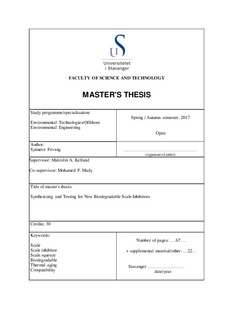| dc.contributor.advisor | Kelland, Malcolm | |
| dc.contributor.author | Fevang, Synnøve | |
| dc.date.accessioned | 2017-10-04T10:38:54Z | |
| dc.date.available | 2017-10-04T10:38:54Z | |
| dc.date.issued | 2017-06 | |
| dc.identifier.uri | http://hdl.handle.net/11250/2458308 | |
| dc.description | Master's thesis in Environmental technology | nb_NO |
| dc.description.abstract | A common production problem for oilfield operation is the formation of inorganic scale in the wellbore, surface facilities and near wellbore formation. Scale formation causes loss in production in most of the production wells mainly after water breakthrough if nothing is done to prevent the formation of scale. The most common method for preventing scale is by use of scale inhibitors. Phosphonate-based scale inhibitors (SIs) have been used in the oil industry for a long time. They have shown excellent inhibition for mainly Group II sulphate scales, but also for other SIs that contain predominating carboxylate or sulphate groups. Phosphonate gives a long squeeze treatment, because it easily binds to reservoir rocks. Most non-polymeric oilfield SIs have generally poor biodegradability, which limits their use in regions with strict environmental regions, such as in the Norwegian continent shelf (NCS). Green (biodegradable) scale inhibitors is on the marked today, but only scale inhibitors that is stable at low temperatures (>100℃). In this study, the focus is on making a green scale inhibitor which is stable at high temperature and high pressure formations.
Seven scale inhibitors have been synthesized from mono- and bis-finitrile attached to aromatics. These SIs include one or two aminobismethylenephosphonate groups, N(CH2PO3H2)2. To investigate their performance as a SI, they have been tested for inhibition of calcium carbonate and sulphate scale, thermal stability, biodegradability in seawater, and their compatibility with calcium (Ca2+) ions. Some of the self-synthesized scale inhibitors shows acceptable to good inhibition for carbonate and sulphate scale. However, none of them where thermal stable at high temperatures.
A part of this study was also to test commercial available scale inhibitors (SIs). Most of the commercial SIs showed good to excellent inhibition, and the one tested for thermal stability was stable.
The biggest challenge is that neighter the self-synthesized or the commercial SIs seems to be biodegradable in seawater, according to OECD 306. | nb_NO |
| dc.language.iso | eng | nb_NO |
| dc.publisher | University of Stavanger, Norway | nb_NO |
| dc.relation.ispartofseries | Masteroppgave/UIS-TN-IMN/2017; | |
| dc.rights | Attribution-NonCommercial-NoDerivatives 4.0 Internasjonal | * |
| dc.rights.uri | http://creativecommons.org/licenses/by-nc-nd/4.0/deed.no | * |
| dc.subject | teknisk miljøvern | nb_NO |
| dc.subject | scale inhibitor | nb_NO |
| dc.subject | biodegradable | nb_NO |
| dc.subject | offshore teknologi | nb_NO |
| dc.title | Synthesizing and Testing for New Biodegradable Scale Inhibitors | nb_NO |
| dc.type | Master thesis | nb_NO |
| dc.subject.nsi | VDP::Technology: 500::Environmental engineering: 610 | nb_NO |

